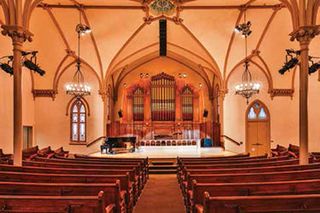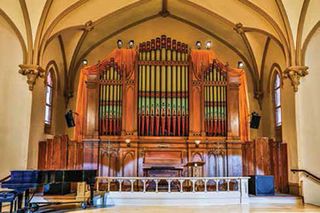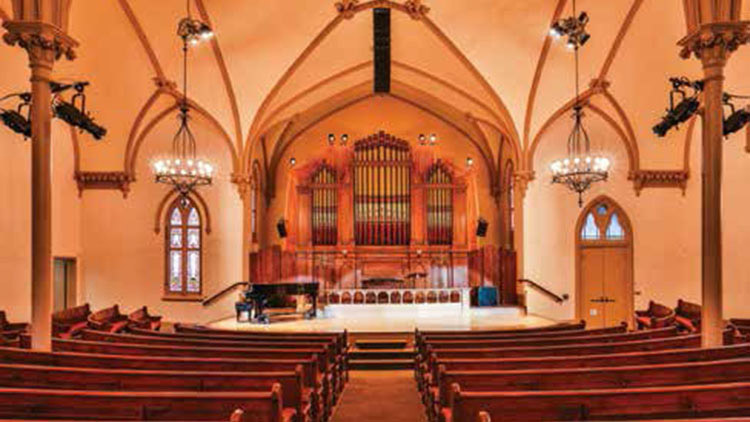Built in 1882, The Old Church is one of the best examples of elaborate High Victorian Gothic architecture in Portland, OR, if not the entire state. Following a decline in its congregation, the building was given new life by a non-profit organization beginning in 1968, which helped ensure the treasured space would be enjoyed by many generations to come. Of course, getting it added to the National Register of Historic Places in 1972 helped, too.

A mono central cluster of six Alcons Audio LR7/120-degree and four LR7/90-degree micro line array modules hang in the historic Old Church space.

Since then, The Old Church has evolved into a unique venue that hosts a wide range of events, including classical and rock music, comedy, lectures, and performances for children. With such a varied schedule, ensuring every act sounds just right is incredibly important, so the board of directors recently set its sights on upgrading its existing portable sound system with a permanent solution—easier said than done in a historic space.
“Because it’s a historic building, we couldn’t touch anything on the walls or the ceiling,” said Justin Fulbright, sales manager at Pro Sound & Lighting, which served as the integrator on the project. That included speakers and sound treatments, which created a challenge in such an open, reflective space. “And of course, aesthetics was one of the biggest issues.”
Working with Gary Stokes of Stokes Sound, a FOH engineer who works with major acts and who assisted on this project, and David Rahn, Alcons Audio North American sales manager, the team found a creative solution in an Alcons Audio LR7 system, hung in a mono central cluster of six LR7/120-degree and four LR7/90-degree micro line array modules, supplemented by fills of six compact VR8 monitors and two mid-sized VR12M monitors, plus a pair of BF181i mkII compact subwoofers. The system is powered by Sentinel3 and Sentinel10 amplified loudspeaker controllers.
“We had to keep as much energy on the listeners as possible, and that’s where Alcons shines,” Fulbright said. “It does a great job getting the sound right where we need it, and when you get outside of the listening field, it keeps the energy off the walls.”
“Because it’s such a live space, toward the back the audience normally gets less direct and more reverberant energy,” Stokes said. “The Alcons center cluster delivers more direct energy to the back of the room, meaning no need for delays. In addition, with the audience in a 260-degree arc, you would only give about five percent of them true stereo coverage anyway.”
Because of the historic venue’s design limitations, structural engineers had to be brought in to install a new beam that could support the array—out of sight, above the original duct work.
“We had to put the line array hang and the signal lines to the speakers through a hole in the air grate,” Fulbright said. “And it couldn’t touch anything in the hole, because that air grate is historic, too.”
Similar careful consideration for both the historic interior and the importance of how the system looks resulted in Pro Sound & Lighting hanging the side outfill speakers on trussing that had been installed around the pipe organ for the lighting, with drapes carefully arranged to mask the truss structure. The subwoofers sit on the stage, so they can be moved in or out depending on the needs of the performance.
For front-of-house needs, Fulbright said they opted for a Midas M32 digital mixer, even though it may be a bit more than the space really needs. “The Old Church isn’t that big of a space, so they may never even need 32 channels of input,” he said. “But in working with their day-today engineers, we found out what they wanted and are comfortable with. Midas does an amazing job, it didn’t max out the budget, and it’s also a good choice for touring techs who come through.”
The install has already proven a success for The Old Church. “As soon as the array was hung, it’s shined from that moment on,” Fulbright said. “Every person who goes into that space comes out raving about the quality of the sound in that room.”
And for Fulbright, the project was an interesting change of pace from his ordinary installs. “It was a challenge, but simply putting a speaker on a wall, or putting a yoke on a speaker and hanging it—that can become a little cookie-cutter,” he said. “So when you’re told you can’t touch anything on the wall or the ceilings, it’s like, ‘Oh, now we get creative!’ That was exciting, and it made the job fun.”
Mary Bakija is a writer and editor based in Brooklyn, NY.













